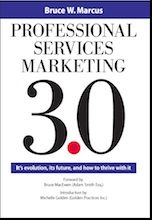The main categories of information for internal communications and management.
By Bruce W. Marcus
Professional Services Marketing 3.0
While the substance of information varies from firm to firm, there are 10 categories that cannot go unconsidered:
- The firm’s goals within the industry (e.g., share of market, quality leadership, shareholder value, increased productivity, and so forth).
- The firm’s business plan and strategy. Firm policies and strategic information, much of which may be confidential. New practice areas, new territories, new opportunities. Not everybody has to know everything, but everybody has to know something specific.
- Daily firm business. Matters concerning firm day-by-day operations, such as medical plans, and secretarial scheduling, pension and health benefits, holiday schedules, expense rules, and other housekeeping information.
- Professional information. What each professional needs to know to enhance his or her professional skills and practice. To remain competitive, key people have to know the latest rules, regulations, laws, findings, results, and both technical and client related techniques.
- Morale factors. Social information, softball scores, weddings and births, the company’s progress and what everybody has contributed to it, and addressing adverse rumors. Specific opportunities at every level, such as sales incentives, rewards for increased productivity.
- Crisis control. The mechanics of dealing with a crisis, how to handle inquiries from the press, how to handle rumors, and what to communicate to staff. A prime consideration here is the concept of no surprises. People who might have to deal with others outside the firm (such as the press) should be aware of crisis information and the process for dealing with it. Crisis management is a function of anticipation and planning before the crisis occurs.
- Client information. Information about clients that should be shared by others in the firm, such as new clients and new client matters, cross-practice needs and opportunities, etc. Who the clients and customers are, who the key people are, who does what for each client, matters pertaining to best serving the client. Some of this may be sensitive; some may be housekeeping. The housekeeping information goes to everybody administratively responsible; the sensitive information only to those who must perform for the client.
- Firm performance. New clients, new business from old clients, cases won, projects completed, feedback on the effectiveness of the firm’s activities, etc.
- Marketing. Firm, practice group, and individual marketing plans and activities, techniques, opportunities, and results. Press releases, new firm literature, new ideas. A firm’s marketing position is everybody’s business.
- Competitive intelligence. What other firms are doing in every aspect that you can discover. Not as benchmarks (which can be retrogressive), but for market trends, ideas, and opportunities.

Bruce W. Marcus is a pioneer in professional services marketing and coauthor of “Client at the Core.” This is adapted from his new book, “Professional Services Marketing 3.0,” available for purchase here.
RELATED: Managing Risk in Client Relations • Your Clients Love You? What If You’re Wrong? • The Three Degrees of Risk • Four Essential Habits for Building Client Trust • The Nine Hallmarks of a Marketing Culture • The Four Cornerstones to Building A Marketing Culture • Getting the Client is Only Half the Battle • Practice Development: It’s Not Rocket Science • Nine Fundamentals for a Healthy Marketing Culture in an Accounting Firm •
Copyright. Used by permission.